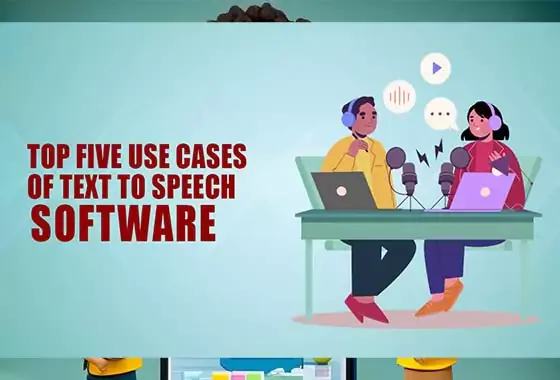Look at the top five uses of text-to-speech software, including how businesses and people may use it to boost productivity and increase communication.
With the advancement of Text to Speech technology, written text may now be converted into realistic audio. The application cases for this software are numerous and constantly evolving, ranging from enhancing accessibility for persons with visual impairments to optimizing workflow procedures. In this article, we'll look at the top five uses of text-to-speech software, including how businesses and people may use it to boost productivity and increase communication. There is probably a use case that appeals to you, whether your goal is to reduce time spent, boost productivity, or improve the accessibility of your content.
What is Text to Speech software?
Users can listen to digital messages instead of reading them because of a technological advancement called TTS software. This has fundamentally altered how individuals receive information, especially those with visual or literacy limitations. The program analyzes text-to-audio versions using artificial voices that users may adjust for speed and tone. The synthesized Text to Speech voices created by AI algorithms produce audio versions of the text, eliminating the need for manual reading and enabling multitasking while consuming digital content, resulting in greater efficiency and convenience. TTS is adaptive and available for all documents because it supports a wide range of file formats, including PDFs, e-books, and web pages.
Five Use Cases of Text-to-Speech Software
The technology of TTS software has been widely accepted due to its capacity to transform written text to voice. This software is utilized for different purposes in diverse sectors and has become a vital instrument in several workplaces. This write-up focuses on the five primary use cases of text-to-speech software.
Use Case 1: Accessibility for the Visually Impaired
To begin with, visually impaired individuals with difficulty reading printed material can utilize text-to-speech software. Https://on4t.com/text-to-speech provides them access to texts on their computers or mobile devices without solely relying on their sense of sight. Additionally, text-to-speech technology is extensively used in education to enhance reading skills and comprehension among students with learning disabilities like dyslexia. Using this software, students can listen and read along with the written words on their screens.
Use Case 2: Language Learning and Pronunciation Practice
Ai voice generator is widely used in language teaching since it provides students with an audio version of texts to listen to while reading the textual content. Text-to-voice is also helpful for honing pronunciation, especially for non-native speakers with trouble pronouncing particular sounds or sentences correctly. The software is a crucial aid for individuals seeking to enhance their speaking abilities, as it assesses their speech patterns and provides guidance on areas that require improvement.
Use Case 3: Audio Books and Podcasts
People who struggle to read or have visual impairments can quickly access information thanks to text-to-voice technology. People can listen to books or articles without straining their eyes or having trouble with dyslexia by turning written text to speak the language. Second, by listening to audiobooks and podcasts while traveling or performing other chores, busy professionals who don't have time for pleasure reading might gain knowledge. They can stay current with events and pick up new information while on the run in this way.
Use Case 4: Banking and Finance
A voice generator is crucial for the banking and financial sectors to improve customer experiences. By speaking of written text, text-to-audio helps blind persons to independently access financial statements, account information, and other vital information. Additionally, financial institutions employ this technology to provide their clients with stock prices, real-time market data, and customized investment advice.
Telecommunications
The telecoms industry has found text-to-speech software to be useful, especially in call center operations. Text-to-voice technology can deliver vital information via automated voice responses, including inquiries about balances, account information, and service updates. Telecommunications firms may effectively handle client inquiries, reduce wait times, and deliver reliable data using text to audio software.
Conclusion
Software that converts into human ai voices has become a game-changing innovation that affects a wide range of sectors while enhancing accessibility and communication. We may anticipate additional technological breakthroughs and the incorporation of TTS software as technology develops, increasing information accessibility and inclusivity.
We recommend the best Online Text to Speech Free Software, where you can get a large number of human Text to Speech voices for your next project.
In the end, if you still have queries about all Use Cases of TTS Software, comment in the below box.
Frequently Asked Questions
Can websites and mobile apps incorporate TTS technology?
Technological development kits simplify incorporating text-to-audio technologies into mobile applications, websites, and other digital platforms.
How accurate is text-to-speech software's pronunciation of various languages?
Multilingual support in the text-to-voice software has been improved. Modern TTS, albeit in accuracy, can vary.
Can text-to-speech software imitate the sounds of real speech?
A voice generator has significantly improved its ability to mimic natural human speech. The artificial voices now sound more human-like, with emphasis, intonation, and even emotions.

